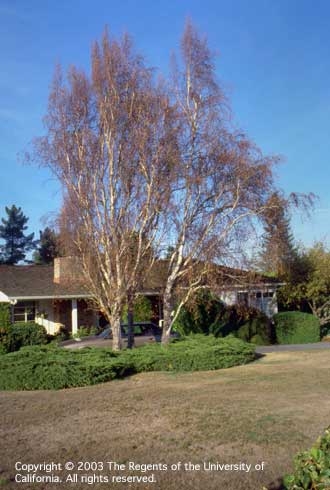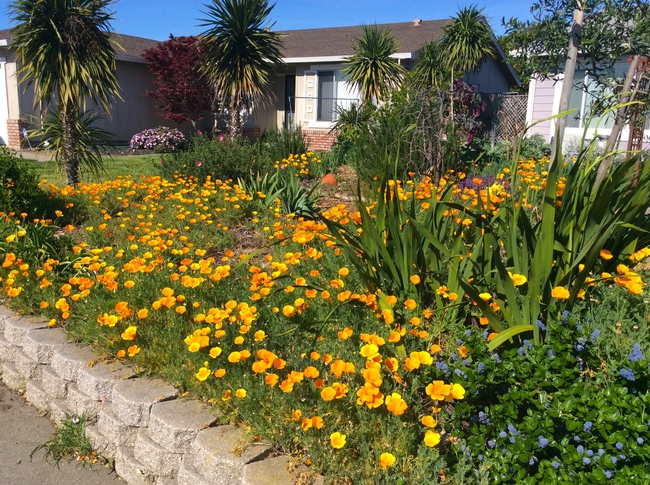With ongoing drought and local water restrictions in place in many areas of California, you may start to see landscape plants suffering from stress caused by a lack of water, calledwater stress. Water-stressed plants can have symptoms that resemble diseases caused by plant pathogens. In addition, plants affected by drought can and be predisposed to disease, opening the way for pathogens to infect the plant when it's not at their healthiest state.
Plants suffering from a lack of water will often show symptoms in their leaves first, losing their luster, then shriveling and drooping.If water stress continues, other symptoms can appear like defoliation, split bark, brown branch tips, stunted growth, and in the worst scenario, plant death. These symptoms could be mistaken for diseases that attack the plant's root and vascular systems like Armillaria root rot and Verticillium wilt.
Diseases promoted by drought
Prolonged drought stress weakens a plant's natural defenses. Water-stressed plants are less able to fight off diseases because they can't make chemicals that protect them from pathogens. Drought-stressed plants have both slower defense reactions and slower wound healing. Split bark from water stress can provide an opening for pathogens to infect. Root systems injured by water stress are more susceptible to root rots like Armillaria.
Canker diseases are often stress related and become particularly damaging during droughts. Common canker diseases like Botryosphaeria canker, Cytospora canker, and Nectria canker can damage or even kill a water-stressed plant. Botryosphaeria canker attacks a wide range of woody plants like oak, alder, redwood, avocado and even California natives like ceanothus and manzanita. This disease is typically more serious in unirrigated landscapes.
Common plants susceptible to water stress
Plants from temperate zones require more water to grow and stay healthy under drought conditions than plants from drier climates. Common ornamental plants that are more susceptible to water stress include azaleas, rhododendrons, tulip poplar, English ivy, sweet gum (Liquidambar), ornamental plums, magnolia, and willow. They lack adaptations to control water loss like extensive root systems and small, leathery leaves. During droughts, they must be carefully tended since they can be injured bywater deficit.
What can you do during a drought andunder water restrictions?
Reduce water waste. Repair anyleaks in the irrigation system and adjust sprinklers to water plants, not pavement. Apply only the amount of waterthat the plants need. Plants need less water in the cooler seasonsso be sure to adjust automatic timers to match water needs.
Switch from sprinklers, which lose a lot of water to evaporation, to a drip irrigation system. Drip irrigation directs the water to the plant's root zoneso less water is wasted. If changing your system isn't possible, water early in the morning when it's cool and less windy.
Trees should be your top water priority. Established trees can survive with one deep irrigation in the spring and one or two deep irrigations during the summer. Continue to water trees growing in a lawn, even if the grass is allowed to die. Mature trees can suffer damage if under drought stress for more than a couple of seasons. If there is no significant rainfall, continue with periodic deep irrigation throughout the year.
Create a water-wise landscape. Replace nonessential grass with ground cover, mulches, decks, or walkways. Some lawn areas can be useful for recreation, cooling, and reducing dust. Drought-tolerant ground covercan be used in place of grass to save water. Choose plants that grow well in your climate. No plant is drought-tolerant until it is fully established. Wait until the fall to introduce new plants so they have winter rains to help them grow.
Vegetables are not drought tolerant so are difficult to keep alive during water restriction. Limit the size of the vegetable garden to only the amount your family needs. Plant shorter season crops. Know the critical times for watering, such as after transplanting and during fruit development. Use compost to add nutrients to the soil and cover with mulch or landscape cloth.
Manage your landscape to be water efficient. Apply a 3” to 4” layer of mulch around plants and across the ground. Control weeds, which compete for water with desired plants. Pull weeds when they are small, making sure to remove the roots.
While water restrictions may seem daunting, you can have a healthy, flourishing garden by following these tips and your local municipal water district guidelines.
Further Reading
Hartin J, Geisel P, Harivandi A, Elkin R. 2014. Sustainable Landscaping in California. UC ANR Publication 8504. Oakland, CA. https://anrcatalog.ucanr.edu/pdf/8504.pdf
Hartin J, Oki L, Fujino D, Faber B. 2015. Keeping Plants Alive During Drought Restrictions. UC ANR Publication 8553. Oakland, CA. https://anrcatalog.ucanr.edu/pdf/8553.pdf
[Originally published in the UC IPM Home & Garden Pest Newsletter, Summer 2022 issue]
Contributor - Associate Director for Urban & Community IPM/ Area Urban IPM Advisor

